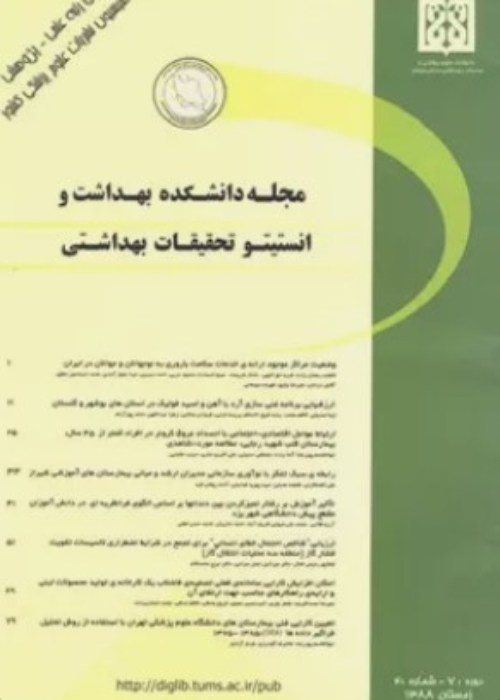Survey of climatic condition of Malaria disease outbreak in Iran using GIS
Author(s):
Abstract:
Background And Aim
Malaria as a mosquito-borne disease is largely dependent on climatic conditions. Temperature, rainfall and relative humidity are considered as climatic factors affecting the geographical distribution of this disease. These climatic factors have definite roles not only in the growth and proliferation of the mosquito Anopheles but also in the parasite Plasmodium activity. The purpose of this study was to find in which regions of Iran climatic conditions favour spread of malaria. Material And Methods
Data on 3 climatic factors, including the mean monthly temperature, rainfall and mixed ratio of humidity, obtained from 31 synoptic meteorological stations during the 30-year period 1975-2005 were used. By running the informative filters through map algebra tools in the Geographical Information System (GIS), the synoptic meteorological stations were classified into 4 groups in terms of climatic conditions favouring activity and proliferation of the mosquito Anopheles and the parasite Plasmodium. Then the regions were interpolated in terms of climate risk of malaria incidence using the tension Spiline interpolation method. Results
The maps of climatic potential malaria risk indicated that the southern provinces including Hormozgan, Bushehr and Khuzestan, southern parts of Sistan-Balouchistan province, such as Chabahar and Nikshahr, as well as Northern provinces of the country, including Mazandaran and Gilan, have the highest climatic potential for risk of malaria spread. On the other hand, provinces in the North Western region, including West and East Azarbaijan, Ardebil, Kurdistan and Zanjan, have the lowest climatic potential risk of malaria spread. Further analysis of the data showed that a large segment of the population is living in regions with medium- to high-risk zones. Conclusion
The findings of this study can be used when designing malaria control programs to identify different regions in terms of climate-based malaria risk. The presented risk map of malaria in this study is completely based on climatic factors. The disconformity between these presented climate-based maps and the observed high-risk map is due to such factors as socioeconomic and lifestyle changes, as well as border problems (foreign subjects entering the country).Keywords:
Language:
Persian
Published:
Scientific Journal of School of Public Health and Institute of Public Health Research, Volume:10 Issue: 3, 2013
Page:
41
magiran.com/p1090385
دانلود و مطالعه متن این مقاله با یکی از روشهای زیر امکان پذیر است:
اشتراک شخصی
با عضویت و پرداخت آنلاین حق اشتراک یکساله به مبلغ 1,390,000ريال میتوانید 70 عنوان مطلب دانلود کنید!
اشتراک سازمانی
به کتابخانه دانشگاه یا محل کار خود پیشنهاد کنید تا اشتراک سازمانی این پایگاه را برای دسترسی نامحدود همه کاربران به متن مطالب تهیه نمایند!
توجه!
- حق عضویت دریافتی صرف حمایت از نشریات عضو و نگهداری، تکمیل و توسعه مگیران میشود.
- پرداخت حق اشتراک و دانلود مقالات اجازه بازنشر آن در سایر رسانههای چاپی و دیجیتال را به کاربر نمیدهد.
دسترسی سراسری کاربران دانشگاه پیام نور!
اعضای هیئت علمی و دانشجویان دانشگاه پیام نور در سراسر کشور، در صورت ثبت نام با ایمیل دانشگاهی، تا پایان فروردین ماه 1403 به مقالات سایت دسترسی خواهند داشت!
In order to view content subscription is required
Personal subscription
Subscribe magiran.com for 70 € euros via PayPal and download 70 articles during a year.
Organization subscription
Please contact us to subscribe your university or library for unlimited access!


